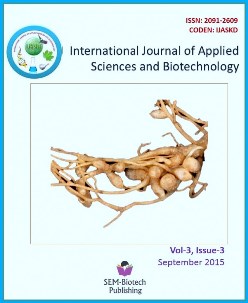Prevalence of Demodectic Mange in Canines of Kathmandu Valley having Skin Disorder and Its Associated Risk Factors
DOI:
https://doi.org/10.3126/ijasbt.v3i3.13218Keywords:
Demodectic mange, prevalence, risk factors, 10% KOHAbstract
Very little information is available regarding the demographics of the demodicosis in canines of Kathmandu valley and in Nepal as a whole. In this study, we determined the prevalence of the demodicosis and its associated risk factors from 110 canines of Kathmandu valley including both sheltered and free-roaming. The skin scrapping collected was dissolved in 10% KOH for the microscopic diagnosis of the mites. The overall prevalence of demodectic mange was found to be 29.1%. There was significant difference (p<0.05) between the prevalence rate among puppy (49.0%), adult (6.9%) and senior (33.33%). Whereas, there was no significant difference (p>0.05) between the prevalence rate among female (22.9%) and male (36.7%). Similarly, there was no significant difference (p>0.05) between the prevalence rate among short hair (40.7%), medium (25.67%) and long hair (28.5%). The association between the prevalence rate among good health status (10.7%) and poor health status (55.5%) is significant (p<0.05). Similarly, there was significant difference (p<0.05) between the prevalence rate among the free-roaming (48.9%) and the owned dogs (13.1%). At last, there was no significant association (p>0.05) between the prevalence rate among the pure breed (27.7%), cross (25.9%) and mongrel (37.5%). This study shows that demodectic mange is somewhat serious skin infection in canines of Kathmandu valley. The high significant association of age, health status and management with its prevalence suggests that the disease is more common in dogs which are left uncared and whose immune system is disturbed. Whereas, sex, breed and type of the hair of the dog did not have such significant relation with its prevalence. As demodicosis is a huge problem in street dogs, concerned organizations and authorities should develop proper planning for street dog management and their health care.
Int J Appl Sci Biotechnol, Vol 3(3): 459-463
Downloads
2256
1027




